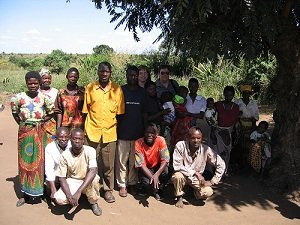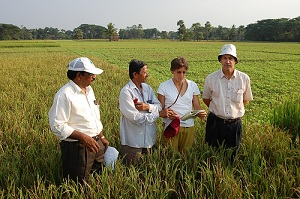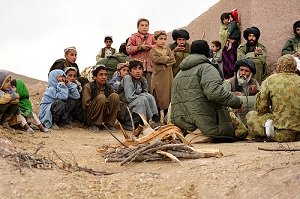Cooperative Systems for Decision Making Include Community Leaders, Action Agencies, and All Stakeholders, and Assure Solutions That Best Serve the Target Community
Cooperative systems involving local communities, their leaders, NGO’s and governmental organizations constitute a community participation approach in planning a water and sanitation system.
Such collective participation of cooperative systems is one of the most important contributions to a project's success.
Note: The content on this page has been adapted from publications of USAID entitled “Water for the World”.
For local participation to be productive, both the community and the action agency must be committed to it from the start, forming cooprative systems that ensure input from all stakeholders.
Educational campaigns on the options for improvements in water and sanitation on the local level are essential to develop the community awareness that leads to responsible participation in developing a system.

The cooperative systems including the community and the action agency must jointly develop a water and sanitation system that can be locally operated and maintained with a minimum of advice and assistance from outsiders.
Community involvement in project planning is essential in all phases of design, construction, and operation and maintenance.
Community involvement is especially important in the areas of financial arrangements, in-kind contributions, labor schedules, legal clearances, selection of acceptable technology, and training in operation and maintenance.
Cooperative Systems and Community Education
Local awareness and understanding of the advantages of water supply and sanitation improvements increase the probability of community participation in developing appropriate water and sanitation facilities.
The success of a water and sanitation project depends on users wanting, understanding, and accepting the system. Community education serves several purposes.
One is to explain to local residents the economic advantages of improved water and sanitation systems.
Another purpose is to familiarize the community with the technologies available so that they will select one they can operate and maintain with a minimum of outside involvement.
A third purpose is to teach villagers which personal and communal water and sanitation practices are harmful to good health so behavioral changes can take place.
Education programs should be arranged through the action agency. The action agency and the village water and sanitation committee should organize the community education campaign using all appropriate cultural channels and reaching all social levels.
The educational effort can be coordinated with other development projects,such as hospital construction or primary health care, as well as with local institutions such as schools and organizations such as mothers' clubs.
Both hygiene and technical education should be integrated into all stages of the planning phase. This is best accomplished if local water and sanitation practices are thoroughly understood.
Local water and sanitation beliefs, legends and patterns of water use and excreta disposal should be identified and understood by the health or technical educator.

Some suggested components that cooperative systems can use in health and hygiene education are:
* rules and advantages of personal hygiene,
* rules and advantages of communal hygiene and environmental sanitation,
* methods of water source protection
* rules of water supply protection in the households
* the health reasons for a safe water supply,
* the health reasons for sanitary excreta and refuse disposal.
Convenience and privacy are the most likely reasons people will accept and use new facilities. Even so, local disease statistics and projected economic consequences are good tools for explaining the need for good health.
Examples set by role models such as teachers, engineers, community leaders and even school children can change behavioral patterns in a community.
Visual aids and the mass media are effective supplements to an educational campaign.
Local programs might be organized as:
* hygiene explanations of water and sanitation systems integrated into the construction schedules for laborers,
* family, mother and child education programs in personal and communal hygiene,
* school programs on health and hygiene including demonstrations and supervised good use practices of new facilities at schools,
* manuals for using facilities for use by operation and maintenance personnel,
* environmental sanitation and village clean-up campaigns.
It is difficult to persuade people to change old habits but the difficulty can be lessened by the manner in which change is introduced.
Community leaders should understand problems and solutions early so they can help explain the coming changes.
Leaders can motivate villagers through their own actions and through community approved sanctions for misuse of facilities.
When cooperative systems including community leaders, the village committee, the action agency and the villagers all have similar understandings, they can work toward a common goal.
The action agency must explain and evaluate technical options with the community to determine their social acceptability.
Throughout the project, the cooperative systems of the action agency and the village water and sanitation committee should explain each project activity and the reason for its sequence to the rest of the village.
This can be accomplished at public meetings or in informal discussions.
Community education or data collection done with local participation of the cooperative systems, begun in the early planning stages of a project, will stimulate interest and can help start active community involvement in the project.
Public awareness of technical alternatives and personal and public practices related to hygiene and sanitation can provide health benefits that the provision of a water or sanitation system alone cannot affect.
Formulate Alternatives
The collection and evaluation of field data will often continue throughout the entire project as new options and information are presented.
The action agency will be responsible for appraising the technical field data and identifying the technical options it believes are practically and economically feasible.
The community will be responsible for evaluating its social, cultural and economic situation and identifying options which it prefers.
Before final steps are taken in formulating water supply and sanitation alternatives, the community, with technical assistance from the agency, should clarify its priorities and needs.
It must identify its expectations and capabilities for technical involvement in system operation and maintenance, its own reliable resources (cash, labor, materials, equipment, services), and the support services it will need for education and training in health, construction, operation, maintenance and facility use.
The action agency should identify the technically feasible alternatives which meet local needs and discuss them with the cooperative systems. Each option the agency presents to the community should include:
* a technical description and explanation
* the estimated installation cost,
* installation needs such as construction time, labor, material and equipment,
* operation and maintenance cost,
* the community's operation and maintenance responsibilities,
* estimated total cost,
* funding requirements, sources and availability.
The agency must fully explain the community responsibilities for each option and the support services the agency can provide.
The action agency must keep in mind that the village will be managing its own system in the operation and maintenance stages.
Efficient operation and maintenance of water and sanitation systems in isolated and rural areas requires simple equipment and procedures and as little water treatment as possible.

The cooperative systems of both the action agency and the village must weigh the following factors for each alternative considered:
1. Technical feasibility, based on data collected in preliminary studies
2. Construction needs:
a. Is site (land) available?
b. Can water and sanitation facilities be made available at convenient places for everyone in the villager? Can facilities be extended to new residences?
c. What materials, tools, and equipment are necessary?
d. Which are available locally?
e. How can non-local materials and supplies be obtained?
f. What kind or and how much labor is necessary?
g. Is it available?
h. How much will materials, equipment, and labor cost?
i. When are laborers free for construction?
j. When and how will funding be available?
k. What season is best for construction?
3. Operation and maintenance needs:
a. Will an operating budget be required?
b. Are local personnel available for operation of systems?
c. Are trained personnel for operation and maintenance necessary? How many?
d. Can water agency provide training for operation and maintenance?
e. How much will operation and maintenance cost daily, weekly, and monthly?
f. What minimum costs will be necessary to keep the system going? How will funds be provided?
4. Community needs and preferences.
5. Social, cultural, religious acceptability.
Select a Method
After evaluating all alternatives presented, the most appropriate system for the village must be chosen.
There is often wide variation between the most desirable alternatives and the most workable solutions.
The cooperative systems of the water committee and the action agency must be careful not to choose either a sophisticated but unrealistic system or a system that is realistic but inadequate for meeting the community's needs.
Often, established standards of quantity and quality will have to be balanced off against community preferences.
No system should be selected that involves complicated or expensive designs or equipment. Systems must be technically sound, economically feasible, and acceptable to all segments of the community.
Systems should be chosen for suitability and not prestige, but convenience and aesthetics should not be overlooked.
Any features that exhaust the technical, economic or social resources of the community invite system failure and should not be selected.
Systems using local resources are more likely to succeed than those dependent on outside resources.
It is not always necessary to develop an entirely new system. Small projects and improvements on existing systems may meet current urgent needs and promote village participation.
The project planner should provide information for the village on the costs and efforts involved in minimal level service improvements which can be expanded over time.
The best water supply alternatives are those that provide the community both safe and abundant water from a reliable, accessible and socially acceptable source at the lowest cost.
The best sanitation system alternatives are those which provide the most socially and environmentally acceptable level of effective service at the lowest cost.
Financial Arrangements
Special meetings should be held between cooperative systems including the community and the action agency to analyze finances and sources of support. The community should be instrumental in establishing financial arrangements for the project.
Fundraising instituted by the villagers to help pay part of the capital costs of the water and sanitation system may help pay for recurrent expenses or raise money for other village projects.
Care must be taken to ensure there is equity in contributions and payments.
The financial value of local labor, materials and services can constitute a considerable proportion of total costs.
When the community has contributed to the cost of the system, and has also participated in planning and constructing it, local residents may develop a stronger sense of responsibility for the system.
If the community cannot pay for the project itself, it should arrange for in-kind support. For example, the community can identify sources for items on the materials list and arrange donations, trades or other in-kind commitments.
The community should also be instrumental in developing a financing schedule if at all possible, the action agency should teach elementary accounting to villagers.
The community can:
* price out materials and identify the best price alternatives,
* calculate project costs per family, cost per capita, and total cost,
* decide how the community will pay for construction,
* determine any repayment schedules for loans,
* decide how the community will pay for operation and maintenance,
* decide how and when any fees will be collected,
* determine wages for construction workers and operation and maintenance personnel.
Cooperative Systems Should Set Specific Goals and Write a Project Plan
After the appropriate technology is selected, goals for developing and completing the system should be set.
Set specific goals that can be measured so people can tell when they have reached them. Be sure any necessary legal arrangements are made.
The cooperative systems project goals must clearly state:
* What the project is.
* What the project will accomplish in terms of effort and benefits,
* What methods will be used to complete the project.
* When work will be done.
Write a project plan that incorporates these goals into a specific time frame.
The village committee should help choose personnel for construction, operation and maintenance.
Be Sure to Specify:
* How a construction supervisor will be chosen.
* Who will be the supervisor.
* Who will be construction workers.
* How the operation and maintenance managers will be selected.
* Who the operation and maintenance managers will be.
* Who will keep books and file monthly maintenance and accounting reports.
The cooperative systems of the construction supervisor, the village committee, and the action agency should:
* Make a list of
-- the materials which must be procured outside of the community and their cost, and
-- the materials which can be gathered locally.
* Make an equipment list, including tools and vehicles, and all costs.
* Make a list of where to procure all materials and equipment and set up a schedule for delivery.
The village committee should be instrumental in scheduling labor with the construction supervisor. Identify and specify in the project schedule:
* Tasks for completing construction.
* Which parts of the system can be locally constructed.
* Which parts of the system will have to be constructed outside community.
* Which jobs the community will perform.
* Which jobs the agency will perform.
* Which jobs will require both community and agency work.
* Sequence of tasks.
* When work must be done (according to migration pattern, planting, harvesting, climatic cycles and holidays).
* Schedule of completion dates for construction activities.
The action agency usually arranges for equipment and materials to be delivered to the village.
Delivery needs to be budgeted into project costs. Tools and equipment are generally furnished for project use by the agency.
The community usually pays for construction materially so it is best to use local materials such as sand, gravel and stones whenever possible.
The community should provide facilities for storing materials, tools and equipment at the project site.
This will include an area for storing large equipment and a building for storing smaller items. Transportation within the village should also be provided by the villagers.
The community must help decide where the water and sanitation facilities will be located.
Possibilities for extending the system to individual households or new residents should be explained.
The community must be responsible for establishing an authority to enforce rules about late fee payments and negligent use of the system.
Adequate provision must be made for proper operation and maintenance of a system, at both the local level and through a backup resource arranged through the action agency and located convenient to the village.
The cooperative systems should work together to designate a health education staff and plan a health education program schedule.
The cooperative systems should set up an evaluation schedule for the system. Specify evaluation criteria, when the system will be evaluated, and by whom.Community Approval of Copperative Systems Plan
A written or otherwise acceptable project plan may have to be approved by the cooperative systems of local, regional or national leaders, by the local water agency officials or by funding agencies' officials. It must also be officially approved by the community.
A project plan co-created by the cooperative systems should include:
1. A description of the water and sanitation problem in the community.
2. An explanation of the proposed technical system and its expected benefits including the number of facilities.
3. An explanation of the method of construction to be used.
4. Design drawings (these can be simple at first, but dates for final design drawings must be included in the protect timetable).
5. Community and topographic map showing placement of facilities and location of construction. Show placement of facilities within houseplots and relationships of water supply facilities to sanitation facilities.
6. Costs or constructing system including labor (wages. number of workers, time) tools, equipment, materials, services and land that must be purchased.
7. Cost of operating and maintaining project for a specified period of time (per year or per month).
8. Schedule for implementation, including seasonal considerations, timetables for each phase of the project and total time necessary.
If the community accepts the proposal and the responsibilities involved, a formal agreement should be made.
Designing and building the system should begin according to the work schedule proposed.
Return to "CBO's and SHG's" from "Cooperative Systems"
Return "Home"






